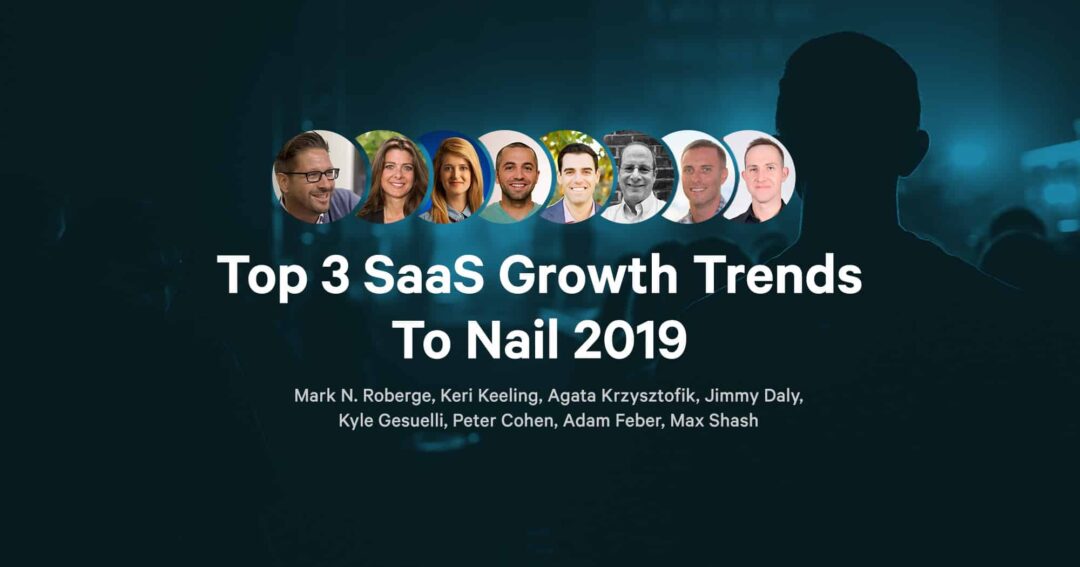Growing a business is hard work. Growing a SaaS business isn’t just hard, but also has its own challenges.
Even though there’s no magic pill for SaaS growth, there are certain trends, approaches, and strategies that can get you to the right place in your business and become a better company. But what are they?
Do you need to keep an eye on acquisition or focus more on sales? Strengthen your retention or be flexible listening to what your customers say and do? When the market changes, how do you move along?
We’ve been growing Reply for 4 years now, but it’s never the same with another business, so we reached out to top experts, asked them The Question and are ready to share our findings with you.
Mark Roberge is a Senior Lecturer in the Entrepreneurial Management Unit at the Harvard Business School. He teaches Entrepreneurial Sales and Marketing in the second-year MBA program in the Fall term and The Entrepreneurial Manager and Startup Bootcamp in the first-year MBA program in the Spring and Winter terms.
I believe the primary SaaS growth trend for 2019 will be prioritizing customer value creation as a precursor to accelerating growth.
To operational this priority shift, organizations will define and measure their leading indicator of customer retention as an important, if not most important, metric to rally around.
Organizations will align marketing, sales, customer success, and product around the leading indicator and customer value creation.
Keri is a results-driven Customer Success leader with deep experience in helping SaaS vendors build and grow their Customer Success team’s operations and strategies. With over 21 years of experience, she has built Success teams for companies that range in size from start-up to publicly-traded. She’s been named in the top 100 Customer Success influencers for the past 4 years.
Welcome to 2019! It’s no secret that a large percentage of growth in SaaS stems from the existing customer (subscription) base. The adoption of Customer Success teams and/or programs is one of the most successful means to produce growth; that’s not to mention that CS typically owns retention along with growth. Here are a few growth trends to consider accelerating in 2019:
- Prove your strategic value
- Value REALIZED(!)
- CX and CS gets married
1. Prove your strategic value
It’s not unusual for your Customer Success team to be the first point of contact for any and all of your customer’s needs. In many cases, being the first point of contact leads your CS efforts down a path of producing immediate gratification for your customers.
This situation isn’t always bad; however, satisfying immediate needs for your customers isn’t the same as producing strategic value. That’s a longer-term strategy and takes mutual commitment.
Customers are coming to expect a higher level of engagement and sophistication from their SaaS vendors that goes beyond meeting their technical needs. Your customers are likely looking for a business partner to help them win in their respective markets.
To assure that your customers get the most from the value your product provides, focus on their use case. Leverage two highly effective processes that promote use case definition and expansion:
- Success Planning
Create a plan with your customer that defines the goals your product/service will help your customer achieve over the coming few quarters. - Adoption Sessions
Work with your customers to enable their adoption of the key feature/functionality of your product. This can be done programmatically or through your CSM team.
2. Value REALIZED(!)
It’s not enough to provide strategic value to your customer. The customer has to understand and recognize that value. Once you’ve set up a success plan with your customer, ensure that you’re leveraging a Business Review process to read back the attainment of the goals / KPIs that both you and your customer are working diligently to achieve. Create a standard cadence in which your customer receives a “report card” of sorts showing them their KPI attainment as well as money/time/effort/etc. they saved by using your product.
3. CX and CS gets married
There’s a lot of focus on Customer Experience right now. Ensuring that your customers have a great relationship with your entire brand will lead to both retention and growth. In addition, creating a solid customer experience will drive added value with your customers and have a positive impact on your Customer Success efforts. Leverage tools like Journey mapping, NPS/CSAT surveys, improve your onboarding process and personalize your customer’s experience.
2019 is going to be a great year! We’ve moved from 2018 being the year of the customer, to 2019 being the year of our Customer’s success!
Agata is currently Head of Growth in GrooveHQ. Marketing and community growth-hacker experienced in building high-performing teams, engaged user communities, and successful lead generation strategies. She’s passionate about finding innovative solutions to problems and offering the best user experience with the product.
- We saw a big rise in chatbots in 2018 and this trend will continue in 2019. More SaaS companies will start embracing bots technology as part of their inbound marketing efforts either via messaging apps such as Facebook Messenger or via on-site chat solutions.
- As such, bots will become more and more sophisticated and better at understanding complex requests, personalizing responses, and improving interactions based on previous learnings. Chatbots will contribute to another important trend — hyper-personalized experience throughout the full buyer’s journey.
- By 2020, customer experience is predicted to overtake price and product as the key brand differentiator. Personalization and context-driven experience will become important contributors to “wowing” customers at every step of their journey. Starting with a dynamic website copy personalized with the help of such tools as for example, the RightMessage and ending with signal-based support with the help of chat solutions integrated within the product interface, companies able to nail personalization will nail growth.
Jimmy is a longtime B2B content marketer. He’s run content marketing for Vero, QuickBooks and now Animalz. He’s also freelanced, advised Fortune 500 companies, worked in account management and started successful blogs from scratch.
- Don’t treat your blog like a publication. Instead, organize your content and your editorial calendar like a library. Choose your topics and cover them from A to Z.
- Balance your SEO content with movement-first content — this means writing posts that can be shared based on their insightfulness alone.
- Eliminate waste in your content marketing spend by addressing the middle and bottom of the funnel instead of investing heavily in the top of the funnel.
Kyle Gesuelli is the Head of Growth at Frame.io, the leading collaboration platform for video teams. Prior to joining Frame.io, Kyle ran growth at Handy—often referred to as the “Uber for home services.” His hands-on experience in marketing, product, and analytics put him right at home in the growth lane.
- Accelerating the growth of teams within software products by leveraging existing digital relationships – Google contacts, Slack contacts, social connections, etc. Many SaaS products drive coordination and collaboration among an existing team. Leveraging the existing relationships in other tools to recreate the “team” in your SaaS product is a great way to drive faster engagement, more seats, and a higher contract value.
- Doubling down on content and SEO for both acquisition and retention. Looking back at 2018, 50% of our non-direct user acquisition was driven by our blog and other content initiatives at a much lower CPA and CAC than performance marketing. We grew traffic 10X with a team of just 2 editors and an outsourced bench of writers who wrote about their professional work in video production on a regular basis. Investing in new content and better on-site conversion should have strong ROI in 2019.
- A data-driven approach to driving down acquisition costs. Direct response campaigns through social channels are becoming more difficult and costly as these channels get even more saturated. Simple lookalikes just don’t cut it anymore. Using account activity (collected by Segment) and lead/account scoring (leveraging tools like Clearbit) help you focus on just types of customers most likely to convert while cutting out the chaff.
Peter is the principal of SaaS Marketing Strategy Advisors. Before he started his own firm, he’d spent many years in marketing positions with Lotus, IBM, and other companies. He started SaaS Marketing Strategy Advisors to share that experience with his clients.
- SaaS is more than software. Along with a set of software features, people are also buying the vendor’s expertise. They expect expert help in implementing, training and supporting the service. In fact, though a prospective customer may see the potential value of the software features, if they cannot get past their fear of a poor experience in implementing the solution, learning to use it, or getting help, they won’t buy it. Marketers ought to be selling these elements of the solution, not just the software features. See “Your SaaS prospects could be afraid to buy”.
- Force prospects to make a decision. SaaS marketers should keep in mind that their prospective customers are busy and not dedicated full-time to evaluating SaaS solutions. They have day jobs, such as running HR, sales, or finance. Unless marketers make it crystal clear that there’s a cost to “doing nothing,” prospects find other priorities to concentrate on and put off evaluating and buying a solution forever.
- Get the message right first. Nothing particularly “2019” about this advice, but it’s always worth reminding ourselves. With all the focus on tactics – social media, SEO, paid search, optimizing websites, etc. – SaaS marketers should remember that a compelling and consistent message is an essential foundation for all of these programs to work. A Facebook campaign, webinar series, or drip email campaign that doesn’t mean anything to the prospective buyer and doesn’t motivate them to act, isn’t worth very much.
Over a decade of successful product management and product marketing experience with a passion for growing SaaS companies that help people work more efficiently. Excel in organizing teams and project workflows from planning stages through implementation with a unique ability to blend product management, marketing, and user experience to create websites and applications used and loved by millions.
- Optimize your pricing! Pricing should never be considered “set in stone” and with the SaaS landscape becoming more and more saturated, you need to find a way to align offers—the combination of product features, usage, and price—with value metrics so that prospects feel good about the value they will gain by becoming paying customers. Experiment with different billing models, packaging, and pricing in 2019 to increase average revenue per account, decrease churn, and increase lifetime value.
- Differentiate your product! To add to the point above about saturation in SaaS, I predict that a lot of companies in 2019 will live or die by finding ways to differentiate. Many SaaS products have similar functionality so unless you plan to rely on the cheapest price to drive conversions, you’ll need to get creative with your product’s features and functionality to stand out in a sea of SaaS. Make it a goal to talk to as many current customers as possible, understand their needs/wants, know what your competition has (and doesn’t have), and then plan your 2019 product roadmap with some marketable, differentiating features.
- Identify and optimize your conversion funnels! Every SaaS company wants unicorn logos on their site to solidify that they are the best option—and have social proof to back it up. But unless you’re well funded, you can’t leave money on the table by spending all of your marketing/sales energy chasing big fish. Think about how different segments such as touchless/unassisted, sales assisted, and sales influenced/led interact with your website, product, and sales team to identify and score the different conversion funnels. The end goal is to keep customer count and recurring revenue growing with low touch startup/SMB customers to free up time and fund your efforts chasing mid-market/enterprise prospects.
Max is a Chief Marketing Officer for IO Technology – one of the industry’s leaders in editorial analytics. IO Technologies helps every newsroom team member make faster and more accurate decisions through using an actionable analytics dashboard. Prior to IO Technologies, Max worked for the gaming industry where he has launched 11 new products and acquired 60,000,000+ new users.
1.Investing more in maintaining the core audience
SaaS companies are working hard on lead generation and lead nurturing. Being in the business of analytics, IO Technologies recognizes that many companies are increasing efforts to understand their core audience’s needs and to improve user retention.
Investing more in maintaining the core audience means making the product exceed the core audience’s expectations. That means refreshing value proposition and adding new features.
Having a substantial core audience is a necessary factor for product market fit and SaaS growth. A loyal core audience produces brand advocates and recommendations that bring new, free leads, coming by recommendation and thus helping the whole thing to grow faster.
2. Actionable insights based on data analytics to be delivered to every team member
The competition level for most SaaS businesses is becoming more severe by the day. In 2019, an average SaaS employee will be making more decisions than in 2018. Every decision should be done as fast as possible and as accurate as possible. One of the easiest ways to achieve that is to base decisions on data.
That’s why in 2019 businesses should provide actionable analytics and data insights to every single team member. Not only is it the PPC specialists that should be watching conversion rate (CR) drop, but so too should every other team member keep their eyes on the ball.
For example, a content creator should monitor readability, engagement time and leads nurtured by content. Customer success should note the utilization rate decrease and prevent churn.
Most teams have no time and no skills to prepare, aggregate, and export data from Google Analytics, Amplitude, and 50+ other analytics software packages. Actionable insights are expected to be delivered by dashboard presentation, email or push notifications.
All this is within IO’s circle of influence.
3.Making products be more business vertical-specific
During previous years, SaaS developers focused on ‘horizontal’ target audiences, providing solutions to specific business units (sales, marketing, support), no matter the business vertical.
In 2019, more players will be seeking competitive advantages and focusing on the vertical approach. As of today, we can already witness many ‘horizontal vs vertical’ debates. Targeting a specific business sector allows for discovering and solving unobvious industry problems, thus delivering more value.
Thanks to all our experts for their generosity with their time and knowledge!
There’s a lot of value here, but don’t overwhelm yourself by trying to implement all trends and recommendations at once.
Pick the ones that appeal to your business the most and set a series of controlled experiments to see what works the best.
The important thing is to act. By following these experts’ advice, you can dramatically improve your SaaS business growth and set new criteria for success this year.
Have some other trends for 2019? Feel free to share in comments.














